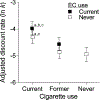Delay discounting and e-cigarette use: An investigation in current, former, and never cigarette smokers
- PMID: 30121475
- PMCID: PMC6390278
- DOI: 10.1016/j.drugalcdep.2018.06.034
Delay discounting and e-cigarette use: An investigation in current, former, and never cigarette smokers
Abstract
Background: Cigarette smokers show greater delay discounting (devaluation of delayed consequences) than non-smokers, suggesting that rapid devaluation of the future contributes to tobacco use through a mechanism in which tobacco-related health consequences are too delayed to discourage smoking. However, little work has quantified delay discounting in relation to electronic cigarette (EC) use, a tobacco product that many users believe to pose fewer negative health consequences than cigarettes.
Methods: We assessed discounting of delayed monetary rewards in a web-based sample of 976 participants, stratified by both EC use (current and never) and cigarette use (current, former, and never).
Results: Controlling for demographic variance, current EC users generally showed greater discounting than never EC users (p = .019). Current cigarette smokers also showed greater discounting than former and never smokers (p < .001). However, the between-group difference for EC use was much smaller (ηp2 = .006) than for cigarette use (ηp2 = .026). Moreover, differences in discounting in relation to EC use were not statistically apparent in most pairwise comparisons. Most notably, the difference between former smokers who achieved smoking cessation by transitioning to ECs (i.e., exclusive EC users) and those who have never used ECs or cigarettes was nonsignificant and small (ηp2 = .010).
Conclusions: The smaller effect size for the association between delay discounting and current EC use, relative to current cigarette use, suggests that public perception of ECs as a safer alternative to cigarettes attenuates the role of delay discounting in decisions to use ECs.
Keywords: Cigarettes; Delay discounting; Electronic cigarettes; Tobacco; e-cigarettes.
Copyright © 2018. Published by Elsevier B.V.
Conflict of interest statement
Conflicts of interest
WKB is a principal of HealthSim, LLC and Notifius, LLC; a scientific advisory board member of Sober Grid, Inc. and DxRx, Inc.; and a consultant for ProPhase, LLC and Teva Branded Pharmaceutical Products R &D, Inc. KMC has received grant funding from Pfizer Inc. to study the impact of a hospital-based tobacco cessation intervention and has received funding as an expert witness in litigation filed against the tobacco industry. None of the other authors has any real or potential conflict(s) of interest.
Figures



Similar articles
-
Delay discounting validity and e-cigarette use: A comparison in e-cigarette users, combustible cigarette users, dual users, and nonusers.Exp Clin Psychopharmacol. 2025 Feb;33(1):68-76. doi: 10.1037/pha0000748. Epub 2024 Nov 7. Exp Clin Psychopharmacol. 2025. PMID: 39509210
-
Impulsivity and cigarette smoking: delay discounting in current, never, and ex-smokers.Psychopharmacology (Berl). 1999 Oct;146(4):447-54. doi: 10.1007/pl00005490. Psychopharmacology (Berl). 1999. PMID: 10550495
-
To smoke or not to smoke: Does delay discounting affect the proximal choice to smoke?Subst Use Misuse. 2019;54(8):1237-1246. doi: 10.1080/10826084.2018.1528463. Epub 2019 Apr 13. Subst Use Misuse. 2019. PMID: 30982388 Free PMC article.
-
The effect of e-cigarettes on cognitive function: a scoping review.Psychopharmacology (Berl). 2024 Jul;241(7):1287-1297. doi: 10.1007/s00213-024-06607-8. Epub 2024 May 10. Psychopharmacology (Berl). 2024. PMID: 38724716 Free PMC article.
-
Cardiovascular impact of electronic-cigarette use.Trends Cardiovasc Med. 2020 Apr;30(3):133-140. doi: 10.1016/j.tcm.2019.04.006. Epub 2019 Apr 25. Trends Cardiovasc Med. 2020. PMID: 31072697 Review.
Cited by
-
Acute Stress Effect on Delay Discounting and Cannabis Demand Among Individuals Endorsing High-Frequency Cannabis Use.Cannabis. 2025 Feb 1;8(1):21-39. doi: 10.26828/cannabis/2024/000275. eCollection 2025. Cannabis. 2025. PMID: 39968482 Free PMC article.
-
Intersections between environmental reward availability, loss aversion, and delay discounting as potential risk factors for cigarette smoking and other substance use.Prev Med. 2022 Dec;165(Pt B):107270. doi: 10.1016/j.ypmed.2022.107270. Epub 2022 Sep 21. Prev Med. 2022. PMID: 36152818 Free PMC article.
-
Single- and cross-commodity delay discounting of money and e-cigarette liquid in experienced e-cigarette users.Drug Alcohol Depend. 2020 Jan 1;206:107740. doi: 10.1016/j.drugalcdep.2019.107740. Epub 2019 Nov 15. Drug Alcohol Depend. 2020. PMID: 31778948 Free PMC article.
-
Episodic Future Thinking about Smoking-Related Illness: A Preliminary Investigation of Effects on Delay Discounting, Cigarette Craving, and Cigarette Demand.Int J Environ Res Public Health. 2022 Jun 10;19(12):7136. doi: 10.3390/ijerph19127136. Int J Environ Res Public Health. 2022. PMID: 35742385 Free PMC article. Clinical Trial.
-
Smoking Dependence, Time-Discounting, and Sustained Cessation Behavior: A Longitudinal Study of Predominantly Light Smokers.Nicotine Tob Res. 2024 Jan 22;26(2):220-228. doi: 10.1093/ntr/ntad166. Nicotine Tob Res. 2024. PMID: 37648272 Free PMC article.
References
Publication types
MeSH terms
Grants and funding
LinkOut - more resources
Full Text Sources
Other Literature Sources
Medical

